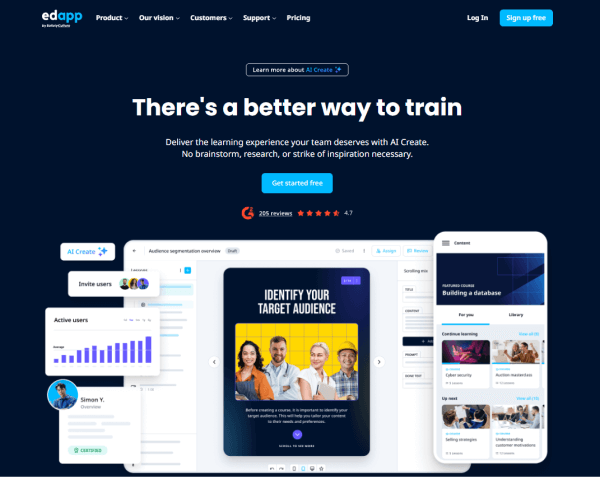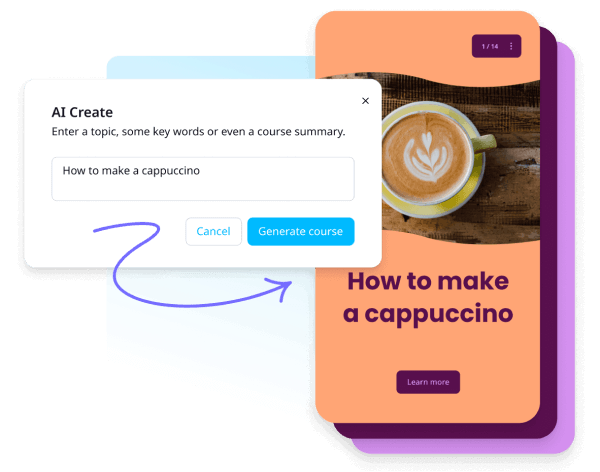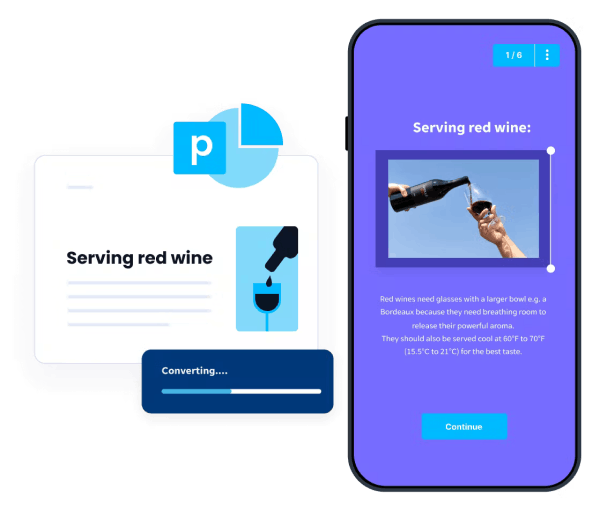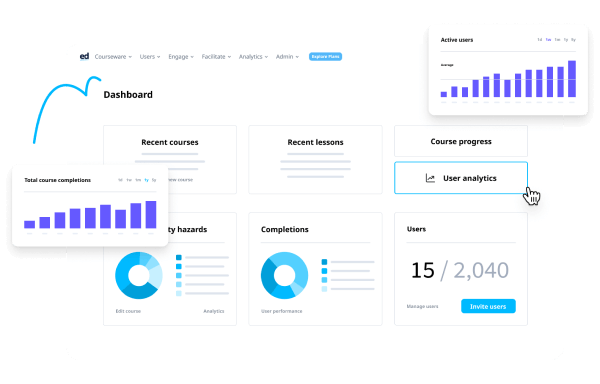The complete guide to creating microlearning courses

In today's digital landscape, it's important to find modern and effective ways of engaging and motivating learners. One strategy that stands out is microlearning, a game-changing approach that's been constantly gaining traction since the early 2000s.
Here, we'll explore how microlearning courses are used for workplace training. We'll delve into the definition, benefits, and examples of microlearning, along with the process of creating one.
What is microlearning?
Microlearning is a modern training approach that breaks down complex topics into bite-sized units or lessons. Compared to traditional longer-duration courses, it's been found to be 17% more effective, appealing to both employees and learning and development (L&D) professionals.

Microlearning courses are specifically designed to give people targeted knowledge or skills they can use immediately at work. They often incorporate a spaced repetition strategy, where learners receive frequent and small pieces of information repeatedly at increasing intervals. This way, learning becomes a habit that's easy to retain and keep in mind.
Because of this, microlearning is applied in most—if not all—corporate training operations. That includes onboarding, just-in-time learning, performance support, mobile learning, continuous learning, compliance training, and skills development programs.
Benefits of microlearning
Microlearning is a highly valued L&D strategy, and it didn't become a popular learning trend for no reason. Let's dive deeper into how microlearning courses can benefit your training initiatives.

- It improves knowledge retention.
Typically, the human brain can only retain up to five new pieces before it becomes lost or overwritten. Microlearning helps you present information in smaller and more focused pieces, so it's easier for learners to understand and remember what they've learned.
- It's flexible and accessible.
Most microlearning materials are designed to be accessible across multiple devices. It doesn't matter if a team member prefers using a smartphone, tablet, or laptop—they can learn wherever and whenever they need to.
- It increases learner engagement.
With microlearning, learner engagement can skyrocket from an industry average of 15% to 90%. That's because you can implement interactive multimedia features like videos, quizzes, and gamification in your lessons. These make the learning journey enjoyable and motivating for learners.
- It saves time and money.
Microlearning can cut development costs in half and boost development speed by three times. It doesn't take a lot of training budget to create and deliver microlearning courses effectively. It's also great for learners with busy schedules as they'll be able to read quickly and finish lessons in as short as 10 minutes.
Getting set for your microlearning journey
When you're getting ready to create microlearning courses, the first thing to do is find a microlearning software that fits your needs perfectly. It should have useful features that can help you navigate your way to seamless training delivery.

Here are some important things to look for when choosing your microlearning app:
- Mobile-friendly design for seamless access on any device.
- Intuitive authoring tool for easy course creation.
- Multimedia approach to enhance engagement and understanding.
- Gamification and interactivity to motivate learners.
- Admin and learner dashboards for efficient tracking and management.
Thankfully, there's a platform that can help you get around any microlearning challenge you may encounter. EdApp is among the best employee training tools built exactly for this.

EdApp is a top-of-the-line free learning management system recognized by industry-leading brands like Dunhill, Deloitte, Mizuno, and Marley Spoon. Microlearning is one of their core strategies along with other powerful training solutions that'll take your workplace training to the next level.
Kick off your microlearning journey today. Sign up with EdApp at no cost.
How to create microlearning courses with EdApp (and best practices!)
Now that you're aware of the basics of microlearning, let's delve into the step-by-step guide for a smooth course creation process. This comprehensive plan includes useful tips and tricks that'll enhance the effectiveness of your training.

Define learning objectives
To start, make sure your microlearning course has clear and specific learning goals so you can make content that's well-targeted to your learners' needs. Here are some questions that can guide you when setting learning objectives:
- What performance gaps or challenges does your microlearning course aim to address?
- What are the knowledge or skills that you want your learners to gain?
- How will the knowledge or skills gained from the course help your learners' job performance or professional growth?
- What are the outcomes or measurable goals that you want to achieve as a training manager through the microlearning course?
Chunk content
Break down your content into bite-sized modules or topics so it's easy to understand. Keep each module focused on one idea or skill to maximize impact and learner retention.
- Start by dividing the content of your course into major topics or learning goals. These are the most important ideas or skills you want your team to learn.
- Once you know what the main topics are, break them down into smaller sub-topics or sub-objectives.
- Arrange the content chunks in a way that's logical and flows smoothly from one topic to another.
- As a general rule, keep your content concise and relevant. Leave out unnecessary details and make sure each piece of content is directly applicable to your learners' needs.

Protip: You can use EdApp's AI Create feature to ease your content chunking process. You can skip all that brainstorming and research, and jump straight to generating bite-sized lessons almost instantly with just a few clicks. It'll reduce your content creation time and increase your productivity by up to 40%.
Engage with multimedia
Make learning more fun by adding multimedia elements to your microlearning courses. You can do this by following these steps:
- Incorporate videos to present processes, examples, or case studies.
- Use images and infographics to visually represent information.
- Consider adding audio elements like narrations, background music, or sound effects for a more immersive learning experience.
- Maintain balance and relevance by making sure your multimedia elements are used purposefully and in moderation. Don't overwhelm learners with excessive media.

With EdApp, you'll be able to create micro-courses easily even if you're not an expert. Take advantage of its creator tool to apply all these versatile media options that'll make your lessons more interesting and visually appealing. This way, you can effortlessly and directly upload and embed videos, audio files, and images into your modules.

If you already have existing learning materials in PDF or PPT format, you can quickly transform them into mini-lessons with EdApp's PowerPoint Converter. And to customize them, you can use an in-built Canva integration for branding. It'll let you play around with logos, fonts, colors, and brand style.
Apply gamification
By adding game-like elements, you'll avoid the "boring" route and instead get your learners more involved with your training process. EdApp's gamification tools can help you boost your learners' interest in learning and give them a sense of healthy competition and success. You can blend these into your microlearning courses by doing these tasks:
- Apply game templates like image-word match, true or false, memory (tile matching), and more.
- Assign points to learners based on their progress, completion of activities, or correct answers in games and quizzes.
- Award badges and banners to recognize achievements and milestones throughout the microlearning course.
- Display leaderboards that showcase learners' progress and scores.
- Incentivize your top learners and completers with real rewards and certificates.

Use spaced repetition
Spaced repetition goes hand in hand with microlearning. EdApp has a feature called Brain Boost that'll let you use spaced repetition to help your learners retain what they've learned.

This is how it works: once your learners complete a course, Brain Boost automatically creates follow-up lessons or quizzes out of previously shown content. It repeats the lessons at spaced intervals, so your learners can focus on the key concepts until they've mastered them.
Track progress and analytics
Take advantage of EdApp's Reporting and Analytics feature to keep an eye on your learners' progress and performance. You can find out how well your microlearning lessons work by looking at how many learners complete them, how engaged they are, and what they've learned.

- Use the engagement dashboard to track compliance and progress.
- Access the performance dashboard to monitor completion rates and learner comprehension.
- Generate actionable reports so you'll know learners who haven’t logged in, began, or finished their courses. Analyze the data to determine knowledge gaps or areas where learners may need additional support or reinforcement.
- Track learner progress over time to pinpoint trends, measure learning growth, and personalize learning experiences based on each learner's progress.
Examples of microlearning courses
Microlearning's flexibility allows it to be used in many different fields and learning situations. To give you a visual representation of microlearning, we've compiled a list of microlearning examples. These are carefully crafted with the help of EdApp's innovative features, such as gamification, quizzes, and interactive elements.
Note that these are editable courses, so feel free to use it if it's relevant to your training or modify them to suit your learning goals.
- How to Demonstrate a 'Can Do' Attitude: The five-part management and leadership course highlights the importance of fostering positivity, promoting a healthy outlook, and overcoming frustration at work. With its mobile-friendly learning format, your learners can conveniently access the content on the go.
- Mental Health & Resiliency in Aged Care Facilities: EdApp’s training program discusses how to develop mental health awareness and emotional resilience against distress at work. Complex topics like practical and evidence-based coping strategies are presented in a simplified way, making it easy for your learners to digest the content.
- The Basics of First Aid: This practical risk management course talks about the best ways to respond to common workplace emergencies like cuts, burns, slips, trips, and falls. There’s a short game-like quiz at the end of the course to help your learners retain what they’ve learned.
- Fire Safety: The safety program tackles how fire accidents begin, how to prevent it, and how to respond in case a fire breaks out in the workplace. It’s divided into four short lessons that’ll only take around 5 to 10 minutes each to complete.
- The Great Climate System: Co-created with AXA Climate, this environmental course delves into the ins and outs of climate change, including topics like natural forcing, and energy excess, and global warming. Throughout the lessons, your learners will come across images and videos that’ll give them an immersive multimedia learning experience.
You might also want to check out EdApp's Course Library for more microlearning courses with topics ranging from various industries like sales, healthcare, manufacturing, retail, education, and more. It has over 1,000 highly-customizable and ready-to-use courses that you can deliver to your teams instantly.

Get the most out of your training classes with microlearning courses
Without microlearning's adaptability and ease of use, it can be challenging to meet the diverse learning needs and preferences of your employees. This often results in lower knowledge retention and decreased engagement, which can ultimately hinder performance and limit professional growth.
By embracing microlearning with EdApp, you can have your company proactively stay ahead in the ever-changing learning landscape. This allows for efficient and effective knowledge transfer and, overall, better learning outcomes.

Start creating microlearning courses with the best free microlearning app! Sign up with EdApp for free today.
Author
Ella Mar
Ella is a content writer for EdApp, an award-winning e-learning management system designed to help companies deliver high-quality workplace training. In her free time, she enjoys painting, reading, or playing with her cat.
